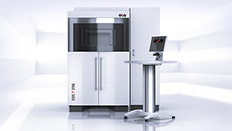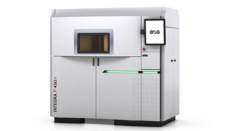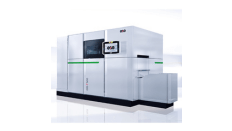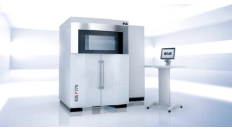Overview
While industrial 3D printing promises more flexibility and creative freedom than traditional manufacturing, understanding different materials and technologies can be a challenge. Here’s your easy path into the limitless world of polymer 3D printing.
Selective laser sintering (SLS), the technology perfected by EOS, uses plastic polymers in powder form that are fused using a precise laser. The result is robust functional parts with high design freedom, as no support structures are required.
The innovative fine detail resolution (FDR) technology uses a laser beam that takes precision to new heights. This is opening the door to extremely stable, filigree parts with an ultra-smooth surface finish across different materials and applications.
Materials
Explore Our Portfolio of High-tech Materials Designed for Metal 3D Printing
FLEXIBLE EOS TPU 1301
The parts made from this white material are extremely hydrolysis-resistant, with high resilience and good tribological properties. The part design influences the degree of flexibility of the parts purposeful.
Typical Applications
- Footwear & lifestyle parts that demand elastomeric properties, e. g. handles, shoe soles
- Automotive & industry parts, e.g. tubes, bellows, seals, gaskets
- Protective sports gear, e.g. helmet cushioning
- Applications usually made from foam can be replaced by lattice structures in EOS TPU 1301
Compatible Printers
- EOS P 396
- EOS P 770
- FORMIGA P 110 Velocis
Properties
- Tensile Modulus 60 MPa
- Tensile Strength 7 MPa
- Elongation at Break 250 %
- Melting Temperature (20°C/min)138 °C
- Density 1080 kg/m³
Highlights
- Great resilience
- Good hydrolysis resistance
- High UV-stability
- Very good shock absorption
- Shore hardness 86 A
- Low refresh rate
DUCTILE PA 1101
The whitish, slightly translucent, additively manufactured parts made from biobased PA 11 are characterized by high impact resistance and elongation at break. They do not splinter even under high mechanical loads.
Typical Applications
- Impact-resistant applications, which may not splinter when applied with a load, e.g. coverings or housings
- Functional parts that require a high elongation at break, e.g. hinges, clips, or buckles
- Eyewear in the consumer goods industry
Compatible Printers
- EOS P 396
- EOS P 770
- FORMIGA P 110 Velocis
- FORMIGA P 110 FDR
Properties
- Tensile Modulus 1600 MPa
- Tensile Strength 48 MPa
- Elongation at Break 45 %
- Melting Temperature (20°C/min)201 °C
- Heat Deflection Temperature (1.80 MPa) 46 °C
- Heat Deflection Temperature (0.65 MPa) 180 °C
- Density 990 kg/m³
Highlights
- High ductility
- High impact resistance
- Balanced property profile
- Biobased material
Downloads
DUCTILE PA 1101 Climate Neutral
The whitish, slightly translucent, additively manufactured parts made from biobased PA 11 are characterized by high impact resistance and elongation at break. They do not splinter even under high mechanical loads.
Typical Applications
- Impact-resistant applications, which may not splinter when applied with a load, e.g. coverings or housings
- Functional parts that require a high elongation at break, e.g. clips or buckles
- Eyewear in the consumer goods industry
Compatible Printers
- EOS P 396
- EOS P 770
- FORMIGA P 110 Velocis
- FORMIGA P 110 FDR
Properties
- Tensile Modulus 1600 MPa
- Tensile Strength 48 MPa
- Elongation at Break 45 %
- Melting Temperature (20°C/min) 201 °C
- Heat Deflection Temperature (1.80 MPa) 46 °C
- Heat Deflection Temperature (0.65 MPa) 180 °C
- Density 990 kg/m³
Highlights
- High ductility
- High impact resistance
- Balanced property profile
- Biobased material
Downloads
BIOCOMPATIBLE PA 2200 Balance
PA 2200, based on polyamide 12, offers a wide range of applications thanks to its very balanced property profile and is the most proven material on the market. PA 2200 is also available as PA 2200 CarbonReduced with a reduced carbon footprint.
Typical Applications
- Production equipment like grippers, jigs and fixtures
- Surgery cutting guides and bone models for the medical industry
- Eyewear in the consumer goods industry
- Spare parts like brackets or covers, e.g., in the automotive industry
- Functional parts for prototyping that include hinges or threads
Compatible Printers
- EOS P 396
- EOS P 500
- EOS P 770
- FORMIGA P 110 Velocis
Properties
- Tensile Modulus 1650 MPa
- Tensile Strength 48 MPa
- Elongation at Break 18 %
- Melting Temperature (20°C/min) 176 °C
- Heat Deflection Temperature (1.80 MPa) 70 °C
- Heat Deflection Temperature (0.65 MPa) 154 °C
- Density 930 kg/m³
Highlights
- Balanced property profile
- Multipurpose material
Download
BIOCOMPATIBLE PA 2200 Top Quality
PA 2200, based on polyamide 12, offers a wide range of applications thanks to its very balanced property profile and is the most proven material on the market. PA 2200 is also available as PA 2200 CarbonReduced with a reduced carbon footprint.
Typical Applications
- Production equipment like grippers, jigs and fixtures
- Surgery cutting guides and bone models for the medical industry
- Eyewear in the consumer goods industry
- Spare parts like brackets or covers, e.g., in the automotive industry
- Functional parts for prototyping that include hinges or threads
Compatible Printers
- EOS P 396
- EOS P 500
- EOS P 770
- FORMIGA P 110 Velocis
Properties
- Tensile Modulus 1650 MPa
- Tensile Strength 48 MPa
- Elongation at Break 18 %
- Melting Temperature (20°C/min) 176 °C
- Heat Deflection Temperature (1.80 MPa) 70 °C
- Heat Deflection Temperature (0.65 MPa) 154 °C
- Density 930 kg/m³
Highlights
- Balanced property profile
- Multipurpose material
Download
BIOCOMPATIBLE PA 2200 Carbon Reduced Balance
PA 2200 CarbonReduced, based on polyamide 12, offers a wide range of applications thanks to its very balanced property profile and is the most proven material on the market. It combines a heavily reduced CO2e footprint with the well-known technical properties of PA 2200.
Typical Applications
- Production equipment like grippers, jigs and fixtures
- Surgery cutting guides and bone models for the medical industry
- Eyewear in the consumer goods industry
- Spare parts like brackets or covers, e.g., in the automotive industry
- Functional parts for prototyping that include hinges or threads
Compatible Printers
- EOS P 396
- EOS P 500
- EOS P 770
- FORMIGA P 110 Velocis
Properties
- Tensile Modulus 1650 MPa
- Tensile Strength 48 MPa
- Elongation at Break 18 %
- Melting Temperature (20°C/min) 176 °C
- Heat Deflection Temperature (1.80 MPa) 70 °C
- Heat Deflection Temperature (0.65 MPa) 154 °C
- Density 930 kg/m³
Highlights
- 100% proven quality and 45% less CO2e
- Balanced property profile
- Multipurpose material
BIOCOMPATIBLE PA 2200 Carbon Reduced Performance
PA 2200 CarbonReduced, based on polyamide 12, offers a wide range of applications thanks to its very balanced property profile and is the most proven material on the market. It combines a heavily reduced CO2e footprint with the well-known technical properties of PA 2200.
Typical Applications
- Production equipment like grippers, jigs and fixtures
- Surgery cutting guides and bone models for the medical industry
- Eyewear in the consumer goods industry
- Spare parts like brackets or covers, e.g., in the automotive industry
- Functional parts for prototyping that include hinges or threads
Compatible Printers
- EOS P 396
- EOS P 500
- EOS P 770
- FORMIGA P 110 Velocis
Properties
- Tensile Modulus 1650 MPa
- Tensile Strength 48 MPa
- Elongation at Break 18 %
- Melting Temperature (20°C/min) 176 °C
- Heat Deflection Temperature (1.80 MPa) 70 °C
- Heat Deflection Temperature (0.65 MPa) 154 °C
- Density 930 kg/m³
Highlights
- 100% proven quality and 45% less CO2e
- Balanced property profile
- Multipurpose material
BIOCOMPATIBLE PA 2200 Carbon Reduced Speed
PA 2200 CarbonReduced, based on polyamide 12, offers a wide range of applications thanks to its very balanced property profile and is the most proven material on the market. It combines a heavily reduced CO2e footprint with the well-known technical properties of PA 2200.
Typical Applications
- Production equipment like grippers, jigs and fixtures
- Surgery cutting guides and bone models for the medical industry
- Eyewear in the consumer goods industry
- Spare parts like brackets or covers, e.g., in the automotive industry
- Functional parts for prototyping that include hinges or threads
Compatible Printers
- EOS P 396
- EOS P 500
- EOS P 770
- FORMIGA P 110 Velocis
Properties
- Tensile Modulus 1650 MPa
- Tensile Strength 48 MPa
- Elongation at Break 18 %
- Melting Temperature (20°C/min) 176 °C
- Heat Deflection Temperature (1.80 MPa) 70 °C
- Heat Deflection Temperature (0.65 MPa) 154 °C
- Density 930 kg/m³
Highlights
- 100% proven quality and 45% less CO2e
- Balanced property profile
- Multipurpose material
BIOCOMPATIBLE PA 2200 Carbon Reduced Top Speed
PA 2200 CarbonReduced, based on polyamide 12, offers a wide range of applications thanks to its very balanced property profile and is the most proven material on the market. It combines a heavily reduced CO2e footprint with the well-known technical properties of PA 2200.
Typical Applications
- Production equipment like grippers, jigs and fixtures
- Surgery cutting guides and bone models for the medical industry
- Eyewear in the consumer goods industry
- Spare parts like brackets or covers, e.g., in the automotive industry
- Functional parts for prototyping that include hinges or threads
Compatible Printers
- EOS P 396
- EOS P 500
- EOS P 770
- FORMIGA P 110 Velocis
Properties
- Tensile Modulus 1650 MPa
- Tensile Strength 48 MPa
- Elongation at Break 18 %
- Melting Temperature (20°C/min) 176 °C
- Heat Deflection Temperature (1.80 MPa) 70 °C
- Heat Deflection Temperature (0.65 MPa) 154 °C
- Density 930 kg/m³
Highlights
- 100% proven quality and 45% less CO2e
- Balanced property profile
- Multipurpose material
BIOCOMPATIBLE PA 2201
Components made from this pigment free polyamide 12 powder are white but appear slightly transparent. With properties otherwise comparable to PA 2200 – strength, rigidity and good chemical resistance – parts made from PA 2201 can be approved for use in the medical industry.
Typical Applications
- Surgery cutting guides and bone models for the medical industry
- Functional parts for prototyping, that include hinges or threads
Compatible Printers
- EOS P 396
- EOS P 500
- EOS P 770
- FORMIGA P 110 Velocis
Properties
- Tensile Modulus 1700 MPa
- Tensile Strength 48 MPa
- Elongation at Break 15 %
- Melting Temperature (20°C/min) 176 °C
- Heat Deflection Temperature (1.80 MPa) 70 °C
- Heat Deflection Temperature (0.45 MPa) 154 °C
- Density 930 kg/m³
Highlights
- Balanced property profile
- Multipurpose material
Download
DUCTILE PA 1102 black
The black, additively manufactured parts are characterized by high impact resistance and elongation at break. They do not splinter even under high mechanical loads and due to the mass-dyed polyamide 11 powder particularly suitable for visible areas that are subject to abrasive wear.
Typical Applications
- Impact-resistant applications, which may not splinter when applied with a load, e.g, coverings or housings
- Functional parts that reuqire a high elongation at break, e.g., clips or buckles
- Eye wear in the consumer goods industry
Compatible Printers
- EOS P 396
- EOS P 770
- FORMIGA P 110 Velocis
Properties
- Tensile Modulus 1560 MPa
- Tensile Strength 48 MPa
- Elongation at Break 45 %
- Melting Temperature (20°C/min) 201 °C
- Heat Deflection Temperature (1.80 MPa) 46 °C
- Heat Deflection Temperature (0.45 MPa) 180 °C
- Density 990 kg/m³
Highlights
- Color stability
- High ductility
- High impact resistance
- From renewable sources
Download
DUCTILE FR-106
The white flame-retardant polyamide 11 is characterized by high ductility combined with excellent strength, making it particularly suitable for manufacturing components with complex geometries, such as housings and load-bearing connecting elements.
Typical Applications
- Automotive and aerospace production
- Housing and enclosure assemblies
- Complex thin wall geometries requiring strength and accuracy
- Ideal for low to mid volume production applications
Compatible Printers
- EOS P 396
Properties
- Tensile Modulus 1392 MPa
- Tensile Strength 46 MPa
- Elongation at Break 38 %
- Melting Temperature (20°C/min) 187 °C
- Heat Deflection Temperature (1.82 MPa) 70 °C
- Heat Deflection Temperature (0.45 MPa) 186 °C
- Density 1070 kg/m³
Highlights
- Fire retardant nylon 11
- Certified to pass the FAR 25.853 60 second vertical burn requirement
- Parts withstand intense functional testing
- Parts are approved for end-use production applications
Download
DUCTILE HP 11-30
Well suited to applications which require superior thermal properties, with maximum performance and consistent properties in XY&Z dimensions.
Typical Applications
- Under hood components
- Wind tunnel display models
- Well suited to applications which require superior thermal properties, with maximum performance and consistent properties in XY&Z dimensions
Compatible Printers
- EOS P 396
Highlights
- Tensile Modulus 3300 MPa
- Tensile Strength 56 MPa
- Elongation at Break 8 %
- Melting Temperature (20°C/min) 187 °C
- Density 990 kg/m³
Highlights
- Isotropic Properties
- Melt compounded Carbon Fiber filled PA11
- High stiffness, high tensile strength
- Electrostatically dissipative
Download
FLAME RETARDANT PA 2210 FR
PA 2210 FR with its good mechanical properties and its outstanding fire properties it is mainly used in the electrical and electronics industry. PA 2210 FR is certified by Underwriters Laboratories (UL).
Typical Applications
- Electrical and electronic parts, e. g. housings
- Railway interiors, e. g. ventilation ducts
- Aircraft interiors, e. g. air valves
Compatible Printers
- EOS P 396
- EOS P 770
Properties
- Tensile Modulus 2500 MPa
- Tensile Strength 46 MPa
- Elongation at Break 4 %
- Melting Temperature (20°C/min) 185 °C
- Heat Deflection Temperature (1.80 MPa) 84 °C
- Heat Deflection Temperature (0.45 MPa) 154 °C
- Density 1060 kg/m³
Highlights
- Flame-retardant
- Halogen-free
- Fire classification UL 94/V-0
- UL certified
- Fire classification FAR 25.853
Download
FLAME RETARDANT PA 2241 FR
Parts from PA 2241 FR show good tensile strength and are suited to be used for aircraft interior applications, e.g., ventilation ducts and exhaust valves. Due to its recyclability the material is very cost-efficient compared to other flame-retardant materials on the market.
Typical Applications
- Aircraft interior parts, e.g., ventilation ducts, exhaust valves or brackets
Compatible Printers
- EOS P 396
- EOS P 770
Properties
- Tensile Modulus 1900 MPa
- Tensile Strength 49 MPa
- Elongation at Break 9 %
- Melting Temperature (20°C/min) 185 °C
- Heat Deflection Temperature (1.80 MPa) 84 °C
- Heat Deflection Temperature (0.45 MPa) 154 °C
- Density 1000 kg/m³
Highlights
- Flame-retardant
- Halogen-based flame retardant
- Refreshable
Download
HIGH PERFORMANCE HT-23
The HT-23 is based on a PEKK resin with 23% Carbon Fiber compounded in and ground to a fine powder.
Typical Applications
- Aerospace
- Mobility industry
- Complex geometries requiring accuracy and feature resolution
- Well suited to applications which require superior thermal properties, with maximum performance and consistent properties in XY&Z dimensions
Compatible Printers
- INTEGRA P 450
Properties
- Tensile Modulus 6500 MPa
- Tensile Strength 71 MPa
- Elongation at Break 1.16 %
- Melting Temperature (20°C/min) 302 °C
- Heat Deflection Temperature (1.80 MPa) 212 °C
- Heat Deflection Temperature (0.45 MPa) 275 °C
- Density 1390 kg/m³
Highlights
- Isotropic properties
- Melt compounded Carbon Fiber filled PEKK
- High melt point and inherently flame retardant
- Chemical resistant
- Certified to pass the FAR 25.853 60 second vertical burn requirement
Download
HIGH PERFORMANCE PEKK 100
Unfilled PEKK combining high impact strength while maintaining high tensile strength.
Typical Applications
- Aerospace
- Mobility industry
- Industrial applications requiring high abrasion resistance and good sliding friction properties
Properties
- Tensile Modulus 4100 MPa
- Tensile Strength 86 MPa
- Elongation at Break 2.4 %
- Heat Deflection Temperature (0.45 MPa) 249 °C
- Heat Deflection Temperature (1.80 MPa) 165 °C
- Density 1290 kg/m³
Highlights
- High chemical resistance at high operating temperatures
- Replacement of injection moulded PA 6 GF (glass fiber filled Polyamide 6)
- High dielectric strength g Material inherent flame retardancy (UL 94-V0)
Download
BIOCOMPATIBLE PA 2200 Performance
PA 2200, based on polyamide 12, offers a wide range of applications thanks to its very balanced property profile and is the most proven material on the market. PA 2200 is also available as PA 2200 CarbonReduced with a reduced carbon footprint.
Typical Applications
- Production equipment like grippers, jigs and fixtures
- Surgery cutting guides and bone models for the medical industry
- Eye wear in the consumer goods industry
- Spare parts like brackets or covers, e.g., in the automotive industry
- Functional parts for prototyping, that include hinges or threads
Compatible Printers
- EOS P 396
- EOS P 500
- EOS P 770
- FORMIGA P 110 Velocis
Properties
- Tensile Modulus 1650 MPa
- Tensile Strength 48 MPa
- Elongation at Break 18 %
- Melting Temperature (20°C/min) 176 °C
- Heat Deflection Temperature (1.80 MPa) 70 °C
- Heat Deflection Temperature (0.65 MPa) 154 °C
- Density 930 kg/m³
Highlights
- 100% proven quality and 45% less CO2e
- Balanced property profile
- Multipurpose material
Download
BIOCOMPATIBLE PA 2200 Speed
PA 2200, based on polyamide 12, offers a wide range of applications thanks to its very balanced property profile and is the most proven material on the market. PA 2200 is also available as PA 2200 CarbonReduced with a reduced carbon footprint.
Typical Applications
- Production equipment like grippers, jigs and fixtures
- Surgery cutting guides and bone models for the medical industry
- Eyewear in the consumer goods industry
- Spare parts like brackets or covers, e.g., in the automotive industry
- Functional parts for prototyping that include hinges or threads
Compatible Printers
- EOS P 396
- EOS P 500
- EOS P 770
- FORMIGA P 110 Velocis
Properties
- Tensile Modulus 1650 MPa
- Tensile Strength 48 MPa
- Elongation at Break 18 %
- Melting Temperature (20°C/min) 176 °C
- Heat Deflection Temperature (1.80 MPa) 70 °C
- Heat Deflection Temperature (0.65 MPa) 154 °C
- Density 930 kg/m³
Highlights
- Balanced property profile
- Multipurpose material
Download
MULTIPURPOSE PA 3200 GF
Parts made from PA 3200 GF show high rigidity while maintaining a good elongation at break. In addition, they are characterized in particular by their special wear resistance, which makes them a perfect fit for increased abrasion resistance requirements.
Typical Applications
- Machine components that require enhanced siffness under load, e.g., housings
- Heavily used parts that require enhanced wear and abrasion resistance
- Forming tools
Compatible Printers
- EOS P 396
- EOS P 770
- FORMIGA P 110 Velocis
Properties
- Tensile Modulus 3200 MPa
- Tensile Strength 51 MPa
- Elongation at Break 9 %
- Melting Temperature (20°C/min) 185 °C
- Heat Deflection Temperature (1.80 MPa) 96 °C
- Heat Deflection Temperature (0.45 MPa) 179 °C
- Density 1200 kg/m³
Highlights
- High stiffness
- Wear resistance
- Improved temperature performance
Download
MULTIPURPOSE Alumide
Parts made from Alumide are characterized by high stiffness, metallic appearance and good post-processing possibilities. The surfaces of alumide components can be very easily refined by grinding, polishing or coating.
Typical Applications
- Design elements
- Production equipment like jigs and fixtures
- Injection mold for small batch production
Compatible Printers
- EOS P 396
- EOS P 770
- FORMIGA P 110 Velocis
Properties
- Tensile Modulus 3800 MPa
- Tensile Strength 48 MPa
- Elongation at Break 4 %
- Melting Temperature (20°C/min) 176 °C
- Heat Deflection Temperature (1.80 MPa) 144 °C
- Heat Deflection Temperature (0.45 MPa) 175 °C
- Density 1360 kg/m³
Highlights
- Thermal conductivity (limited)
- High stiffness
- Easy postprocessing
Download
MULTIPURPOSE PA 640 GSL
This dark gray PA 12 material is filled with both hollow glass beads and carbon fibers. This makes it exceptionally temperature-resistant and rigid, but also very light.
Typical Applications
- Aerospace/UAV components
- Athletic equipment
- Motor sports and racing
- Ideal for applications requiring a balance of strength and lighter weight without sacrificing dimensional stability and surface finish
Compatible Printers
- EOS P 396
Properties
- Tensile Modulus 3816 MPa
- Tensile Strength 49 MPa
- Elongation at Break 3 %
- Heat deflection temperature (1.82 MPa) 170 °C
- Heat Detection Temperature (0.45 MPa) 180 °C
- Density 820 kg/m³
Highlights
- Thermal conductivity (limited)
- High stiffness
- Easy postprocessing






